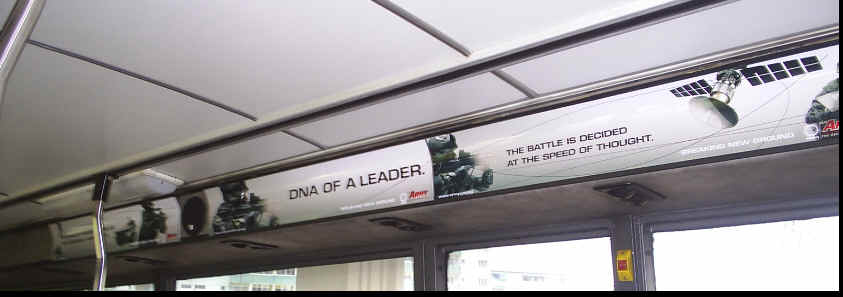
15 November 2005 (Tuesday)
Today we are pushing on up the
Malacca Straits towards Port Dickson on a beautiful motorboat day. No sea, no
wind, no fishing nets across our path and a 1.5 knot current with us. It
doesn’t get much better than this.
In this neck of the woods the water is grey/green and murky and speckled lavishly with flotsam - mostly plastic bags but the odd telegraph pole sized log – just to keep us on our toes.
We cleared out of Singapore on
Saturday morning after a week of gorging on every Chinese or Indian dish that
passed before us. We had to get out while we could still walk unaided.
Clearing out (using the RSYC)
was just a fast administrative process at the marina office. When we cleared in
we did it ourselves. We milled around with all the big ships at the Western
quarantine anchorage, where an Immigration official was put aboard, stamped our
papers and was gone again in a flash. The next day we went to the Harbour board
office to finish clearing. Unless you have controlled goods etc aboard that you
have to declare, you don’t need to go to Customs at all.
Singapore is an amazing city. It’s ringed by very high tech container operations, testament to its source of wealth, and new land reclamations, which must be increasing Singapore’s area every year. The place is clean, beautiful, well run and the right hand does seem to know what the left hand is doing. The systems seem to work – from check in, which was friendly, efficient and well documented; to the transport system which runs on time (every 7 minutes) is clean and moves thousands in minutes; to the car free areas in the city combined with the duties and permits on cars which make it expensive to own one, making the MRT (mass rapid transport) a proposition; to the ban on chewing gum (prohibited import) and system of fines which seem to keep the streets clean. I think it would be a comfortable place to live if you had a job. People here seem to work hard and long hours and seem well off. What a contrast to Indonesia just across the Singapore Strait!
Every time we went on the MRT we
saw the army’s ad on the TVs in the trains. No sound but images of loving
young couples, children with their grans, family get togethers, relaxed sleeping
etc, interspersed with night/b&w shots of soldiers jumping out of
helicopters, running through jungle, crawling through mud etc (ie war movie
heroes) with the final message: “Army – the decisive force”. On the bus we
had “DNA of a Leader”, “The Battle is decided at the Speed of Thought”
and several other “high tech” marketing slogans.

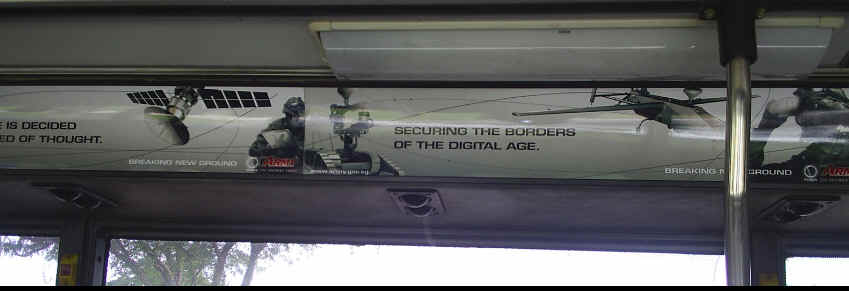
We smiled at the PA system on
the trains, which announces the stations in several languages (including perfect
English - unlike on the trains in Sydney!). The voice reminded us a little of
“Hal” the computer in 2001 A Space Odyssey, with her quiet, controlled
tones.
The people here are exceptionally friendly and, unlike in Indonesia where people were also very good to us, in Singapore they can confidently tell you how the system works or where to catch the bus or where to collect your mail etc etc. (In Indonesia there are no systems that work consistently).
One day we went to visit the
museum at Changi prison. We went there with the usual Australocentric
expectation of learning about the military prisoners of war, but came out moved
by the knowledge of how cruelly the local people were treated by the Japanese.
The trip on the bus was as
interesting in its own way as the museum. Here we discovered first hand that
Singaporean hoodlums are graffitily- challenged. Mostly there is no graffiti
anywhere but on our bus some outlaw had scribbled in texta on the back of the
seat in front: “Don’t put knees on back of seat. Make uncomfortable for
person sitting there” (or words to that effect.)
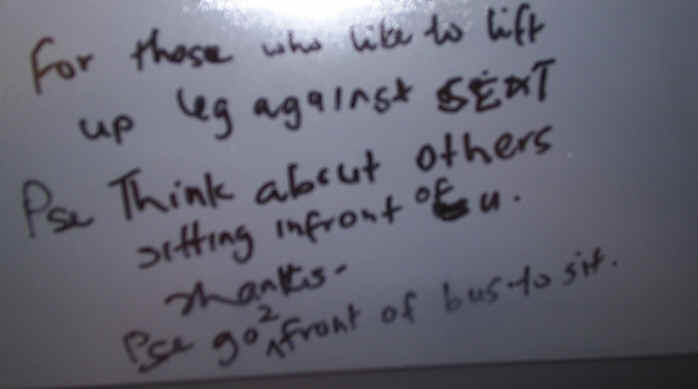
There was far too much for us to take in in a week. I’m sure there is every conceivable kind of food available in Singapore. We loved Little India and tried as many “hawker centres” and Tiger beers as possible. Loved eating curry off banana leaves, roti canai, dhosai mmm mmm!! China town was also lots of fun. I don’t know whether it was because we were there at the end of Deepavali and Hari Raya, or whether Singapore is always in festive garb, but the city was beautifully lit with fairy lights and glowing “silk” elephants, butterflies and flowers.
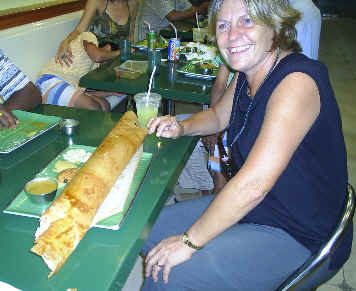

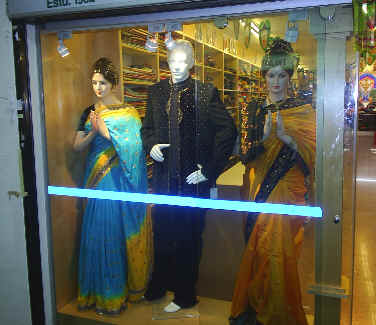
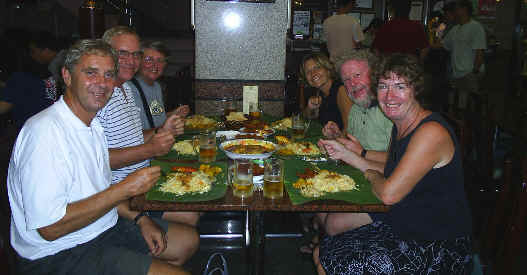
The Republic of Singapore Yacht Club marina, where we stayed, was a story in itself. Architecturally magnificent with soaring sail like roofs and decks, it had a few facilities we weren’t used to included in our tariff of $S40/day (approx$A35). Like swimming pool lagoon, gym and steam bath, library and business/internet centre, and games rooms for children. The berths themselves were rolly (gunwhale to gunwhale) due to the constant coming and going of pilot boats, tugs etc from the facility next door, but they did have golf carts to take you to the club house (just in case you were averse to getting any exercise whatsoever.) Berths were mostly empty.
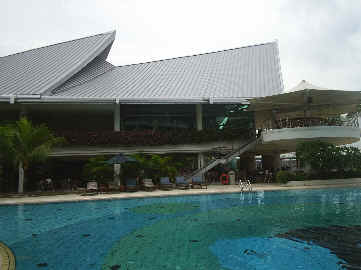
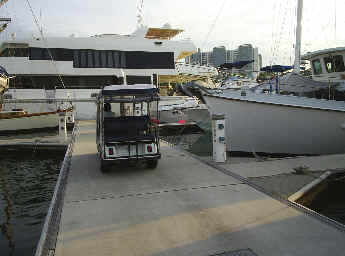
Although we didn’t visit any
of the other marinas, we suspect that there must be an oversupply of berths as
both Raffles marina and the new One Degree Fifteen marina at Sentosa were both
having specials.
After leaving Singapore, our
first Malacca Straits anchorage was at Pisang Island. We might just as well have
been anchored in open sea for all the protection it gave us from the west/north
west, where the wind and sea was coming from. But we stuck it there the night,
despite serious rolling – even with our stabilisers in – because we figured
it was less dangerous than trying to navigate the straits at night with all the
debris, fishing boats, ships and nets to be dodged.
Pulau Besar in the Water
Islands, on the other hand, was very pretty, with large flat boulders forming
natural groins between the baylets. A humungous Mediterranean style resort –
abandoned before opening during the Asian financial “meltdown” at the end of
the nineties – takes up one side of the island.
We cleared in to Malaysia at
Port Dickson, paying the marina to do clearance in and out for us (They had a
“special” on clearances for $A20 both ways). Malaysia requires you to clear
into and out of every port you visit, although the Marina manager told us that
the Immigration authorities told her not to worry about clearing at Lumut and
Penang on the way to Langkawi, unless we planned on spending more than a few
days.
Admiral Marina is every bit in keeping with the Mediterranean/Disney style and scale of architecture that dominates the Port Dickson area. For a little less than $A20/day you can enjoy a lagoon pool with water slide and bridges (and real grass surrounds), gymnasium, 2 tennis courts and a wildly opulent building full of winding staircases and soaring canopy ceilings. Not to mention your marina berth of course (though no laundry – you have to send out for that). A cool down in the pool just before going to bed is a real luxury.
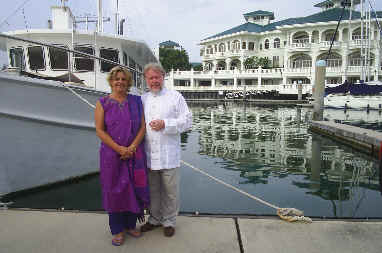

But Singapore it ain’t. Walk
out of the resort precinct and you are back in waist high grass, open drain,
holey footpath land again, similar to Indonesia. Port Dickson is a small town
with a big ship port and nice beaches, which has become a popular place for well
off Malaysians to holiday at. We rather like it. It still has a rather run down,
daggy realness to it, despite developers doing their best to turn it into the
Italian Riviera. We even had a ride in a Nissan Cedric taxi. You don’t get to
do that every day.
While at the marina we took a
do-it-yourself trip to Malacca for a couple of days. From Port Dickson it was an
hour’s ride on a bus to Semberan (RM1.20), the capital of Negeri Sembilan
state. From there, by coach to Malacca in a bit over an hour (RM5.30). This gave
us the chance to rub shoulders with the locals and gawk at the rubber
plantations (declining and moving to Indonesia where labour is cheaper), palm
oil plantations and incredible housing and resort developments (empty or
decaying after flopping during the late nineties “Asian meltdown”). The
Malaysian government’s boost to infrastructure is evident in the magnificent
roads, highway sculpture and plantings.
We stayed right in the centre of
the old town at the Baba House, an original Nyonya building with some
magnificent carved, gold leafed dooverlackies, Chinese antiques etc in the
reception area and rather nondescript rooms. Unlike everyone else who visited
from Port Dickson, we were a little disappointed with old Malacca. It still has
the wonderful old buildings and they have been restored, but now mostly sell
souvenirs or “antiques/art” and have restaurants with menus in English.
Perfectly reasonable for a historical town that relies on tourism, but we rather
like to uncover cultural quirks in authentically daggy surroundings. Of which
there were plenty a few streets from the centre.
Little India was our favourite.
Lots of material shops each with a dozen saris hanging from the awning over the
footpath. But you couldn’t be looking up at them too much as you walked
because you had to watch you didn’t fall into the open drains – just the
right width for a foot to step into.
We also spent a couple of hours
in the fascinating Baba Nyonya Museum just across from our hotel. Babas (male)
and Nyonyas (female) are the descendants of the Chinese who intermarried with
the Malays back in the days when the Portugese were fighting with the Dutch for
control of the trade routes via Malacca. The museum is a house, still owned by
the original family, chockers with carved, gilded screens and staircases,
antique chinese timber and marble chairs inlaid with mother of pearl, Victorian
English tea sets and thousands of artifacts of daily living, including an
outdoor kitchen.
After leaving Port Dickson we
continued to Pangkor Island, intending to use it as a stop en route to Lumut
where we planned to investigate moorings to possibly leave the boat next year
during the wet season and slipways. Pangkor is opposite the mouth of the
Dindings River, where Lumut sits.
But Pangkor Island turned out to be the most naturally beautiful island we have seen since leaving Australia. It has steep jungle covered hills terminating at the sea in white beaches with a few bleached boulders strewn about for added interest. Ashore, around the edges of the island, there is quite a bit of over the top resort development in a few places and stilt house shanty style fishing industry villages at others. But the steep centre is undeveloped. Hornbills still live in the trees and you can see them while waiting for the pink and yellow bus/taxi vans that ply their services around the island.

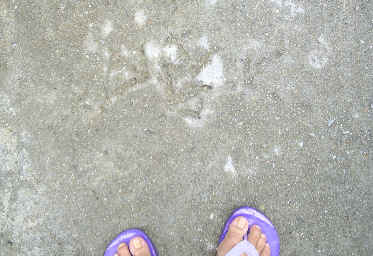
Tour of Pangkor Islandby taxi. Chookprints in cement, Pangkor Island
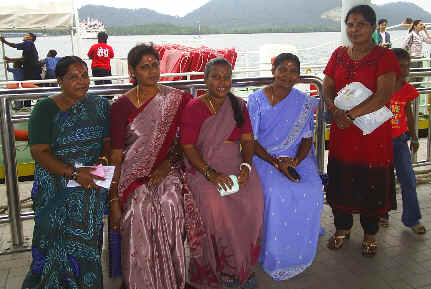 Waiting for the ferry from Pangkor to Lumut.
Waiting for the ferry from Pangkor to Lumut.
Lumut was also a surprise. All we knew about it was that it houses the biggest naval base in Malaysia and that there is calm anchorage and boat minding service up the river. It turned out to be quite a pleasant little town, close to Sitiawan, (where there are reputed to be lots of boating supplies and services) and with the world’s greatest hardware store - all items hanging on hooks up to the ceiling.
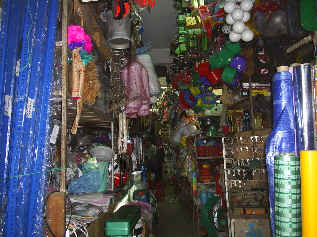
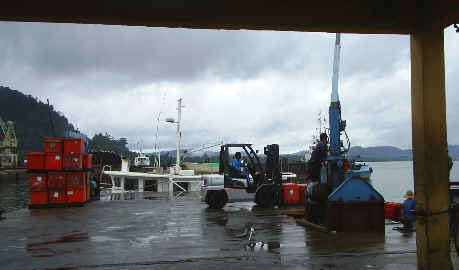
Further up the
river we were able to buy fuel from a very good wharf at the fish co-op for the
cheapest price we have found in SE Asia so far, RM1.50 (A 55c/litr.) It turns
out that the pump price for diesel is RM1-20/l but the marinas all charge around
RM2 (We were quoted RM 1-80 duty free from Langkawi). I suppose if you could
organise a truck to come to a wharf you might be able to get the pump price for
a large quantity. Might investigate this next year. (We shouldn’t need to get
fuel now for six months or so. Between Langkawi and Phuket there are hundreds of
islands within 100nm so we will be CRUISING – diddling between anchorages for
weeks at a time.)
It turns out there are two
railway slipways that serve the fishing fleet, which is based at Pangkor. Philip
took a couple of photos of the underside of Lifeline and went to look and speak
with the owners. The cradles are flatter than we have used and the boat is
chocked from underneath rather than clamped from the side. They have a
weatherworn look and are a bit overgrown. Not our first choice but probably ok
with supervision. And now we have something to compare with those in Penang and
Thailand.
26 November 2005
We are currently motoring
through thin rain and thick overcast the 70nm or so to Penang. Since Bawean in
Indonesia (mid October) we have had rain showers nearly every day with some
lightening 60% of the time. At least the rain and cloud keeps things cooler.
Going out in middle of the day sun here is not an option – it’s searing.
Others have encountered squalls
with 30kn winds for short periods but we have been lucky, with little to no wind
from every direction most of the time. On the radio we hear a lot of whining
from the yachts about the lack of favourable wind and are entirely
unsympathetic.
Everything inside the boat feels
damp until the sun comes out and we have good crops of mildew on our bedroom
ceiling and windowsills etc, which come back within days of cleaning. When does
the NE monsoon (dry) weather start?
13 December 2005
After all the whingeing emails
we’ve had about not hearing from us I thought I would check to see when I last
put key to pixel. Whoops! (We’ve just left Langkawi, Headed for Koh Lipe so
there are one or two things to tell you about Singapore and Malaysia yet.)
Since the second last paragraph
above, the dry season has begun and we have been in Penang and Langkawi – the
two best parts of Malaysia from a boating point of view we think.
Penang (Georgetown) is a great
city. Started by a chappie from the British East India company a year before
Sydney, it is chockers with beautiful restored and unrestored old colonial
buildings, small busy streets crammed with Chinese shophouses, multiple cultures
visible all over the city, thousands of restaurants and food stalls – it’s
just great and fun.
Some streets have ancient buildings, all foundries, all next door to each other with a restaurant and a few houses squeezed between. Another will be all import/trading houses for a block followed by a mosque opposite a hindu temple with a coffee roasting factory, Chinese laundry and tailor etc. Just walking by, peering into the shops, is fascinating (but takes an age to get anywhere). All of this, in the city centre is short walking distance from the Junk anchorage, where we parked.
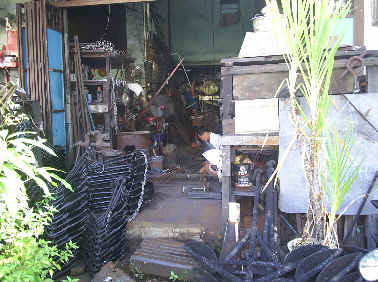
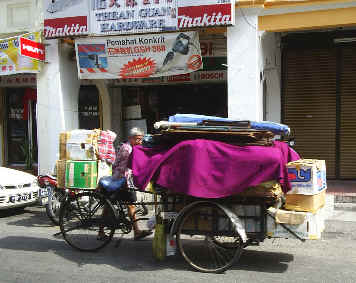

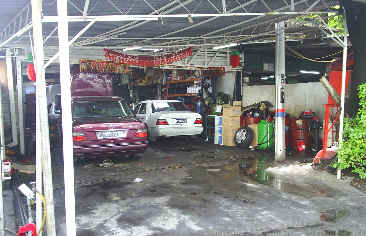 Local Mercedes
workshop.
Local Mercedes
workshop.
Lifeline was moored among large Indonesian fishing boats. Each day we would go ashore and back by hailing one of the Chinese dories from the Chew clan jetty. For 3 ringgit each ($1) we would get to land at the pier then walk through the walkway between the stilt houses over water, discreetly peeping beyond the red lanterns into the front rooms of the Chinese who live there. At the end of the jetty we’d emerge suddenly at the main road, cross it and be immediately in the old city. Philip had to take a picture of one of these dirty, ancient old shops with a tatty leaning awning out front......the local Mercedes servicing outfit! And with plenty of customers.
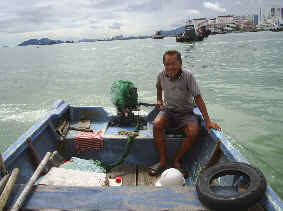
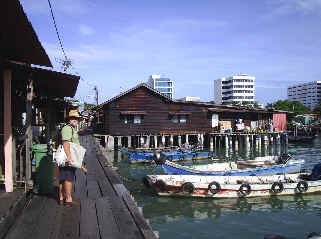

Our boat "boy" who picked us up each day. Philip on the Chew clan jetty. Chew clan jetty.
All sorts of interesting people
joined us coming and going from our boat to the pier, apart from the ancient
boatmen. Quite a few Indonesian fishermen from Aceh, which they say is now OK
after the tsunami, and one Indonesian sugar and urea smuggler, who’s going to
Darwin shortly to do a course in Engineering.
In Penang we were also able to visit “the chemical shop” run by Mr Ong. In an ancient Chinese building open to the street and lined to the ceiling with shelves of old brown and white and green bottles and beakers, it is filled with any restricted material you’d like to buy, from chloroform to nitroglycerin. And it’s right in the middle of Chulia Street, a prime “Chinatown” tourist area. It’s a must-visit for every boatie to buy the bad chemicals they took out of antifouling in Australia twenty years ago to mix into the stuff they buy here, and to buy chloroform to put in the cupboards to fight the SE Asian weevils. Mr Ong is a spry eighty five and testament to the health giving benefits of working with exotic substances.
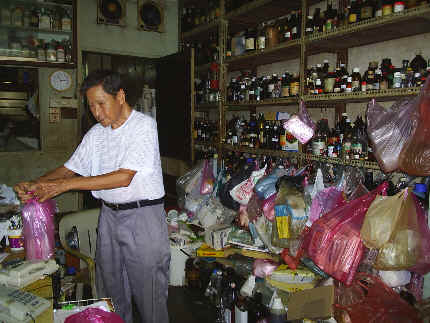 Mr Ong in his shop.
Mr Ong in his shop.
We’ve become so used to seeing
women wearing their hajib scarves that we don’t even notice it anymore. More
often than not the hajib is worn with tight jeans and figure hugging long
sleeved tops. There are also quite a few women in – usually polyester -long
sleeved loose tunic dresses with trousers underneath – this in 32 degree heat,
but they seem not to notice.
Langkawi is a naturally beautiful island with high jungle clad mountains rimmed by white beaches sporting clusters of backpacker bungalow resorts and over the top glamour ones. Development is a funny mix with the feel of Airlie Beach (going quickly up market) meets Canberra meets the junk yard. With cheap booze and chocolates and aroma de drain. Some of Mr Mahathir’s “vision” for Malaysia is evident in the “Big Eagle” (like our Big Banana/Big Pineapple etc) on the wharf and some of the other slightly bizarre tourist “attractions” here. Like the museum of gifts given to him by other countries when he was in power and the park of legends, as well as the soaring cable car built between a couple of peaks. It’s a teensy bit creepy in some ways but we (young pups) like it. And it’s a boating paradise with hundreds of small anchorages in scenic, protected bays.
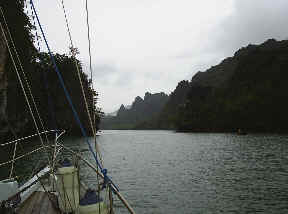
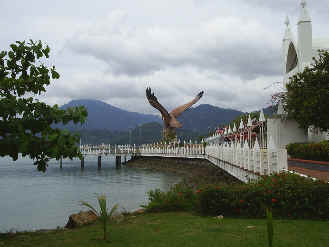
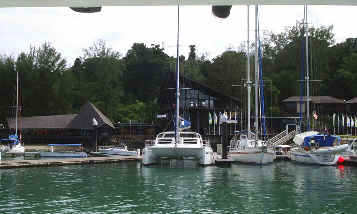 Another beautiful marina with pool.
Another beautiful marina with pool.
In Langkawi the bi-annual LIMA (Langkawi
International Maritime and Aerospace) airshow has been on. Everybody’s army
and/or navy has been represented, including lots of big grey boats anchored
nearby and F18s barrel-rolling overhead. One of the features has been a display
by official jetskis in tandem with camouflaged speed launches spraying them with
water jets. We’ve been impressed with the military women with their black
hajibs tucked into the neck of their uniforms and boots. It’s a tough look.
Also a tough look are the
firemen’s uniforms which are grey camouflage, a la military, but with bright
orange blobs among the grey. So they could blend in with the disaster scene?
Fire trucks are labelled “Bomba”.
Malaysian mosques are quieter than Indonesian ones. Either they have no loudspeakers on the roof or they know how to work the volume. The call to prayer is more subtle and to our ears more attractive. Actually, Islam here is way less obvious here, with many more women out and about and participating fully in daily life.
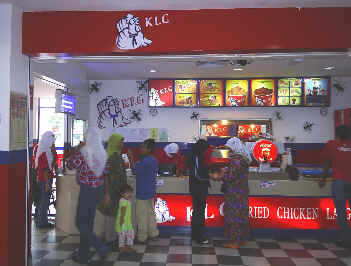 Kentucky Lied Chicken?
Kentucky Lied Chicken?
Since we have been in Malaysia
we have discovered Malaysian dried snacks, which they are very good at. They
deep fry all sorts of stuff – broad beans, pasta, peas etc – and roll them
in curry, chilli, sugar etc and sell them in supermarkets in packets and bulk.
They even have whole stores devoted to snacks and dried fish. Philip now makes
his own blend, buying the cooked ingredients and mixing them to his own secret
recipe. He is also thrilled with the cost of beer here in duty free Langkawi,
where we have now switched from Bintang to Carlsberg as ship’s draught and
stocked up with 10 slabs (@ $A10/slab) for Thailand and Christmas.
Another Malaysian habit we have
picked up on is using a flashing red light at anchor. These beautifully made
objects use 6 LEDs and automatically turn on when dark. They also cost a
ridiculously small amount of money. All in all the perfect anchor light except
for the fact that they look a lot like a port hand mark.
[By the way, do you know how to
find out your porn star name? Take the name of your first dog that you had as a
kid (or the last one you can remember) and the name of the street you lived in,
combine them and voila! (I’m “Princess Shadow” and Philip is “Patch
Grayson”).]
Philip has just pointed out that
we can see Thailand and Malaysia out the side door.
This morning we had a cup of
Indonesian coffee and I found little tiny folded up notes at the bottom of the
bag. I thought they were going to say “Help me. I’m a white slave trapped in
an Indonesian coffee factory” but they actually said something like “Thank
you for choosing X brand. Enjoy!” Mr Dilmah would be pleased.
We also love Malaysian coffee,
particularly iced. Apparently Malaysian local coffee isn’t roasted but fried
with butter and sugar (typical!). We have bought a filter/strainer thingy, which
looks like a loop of wire with a cone of someone’s white knitted nylon soccer
shorts attached. You put in a couple of spoons of coffee for each cup, pour over
boiling water and then simmer for a couple of minutes with the bag in the pot.
Then you pour hot coffee in a glass, add 3 teaspoons of condensed milk and half
a mug of ice. Stir until cold. It’s great.
Well, as we have checked out of
Malaysia and are three days into Thailand now, I’ll wind this up.